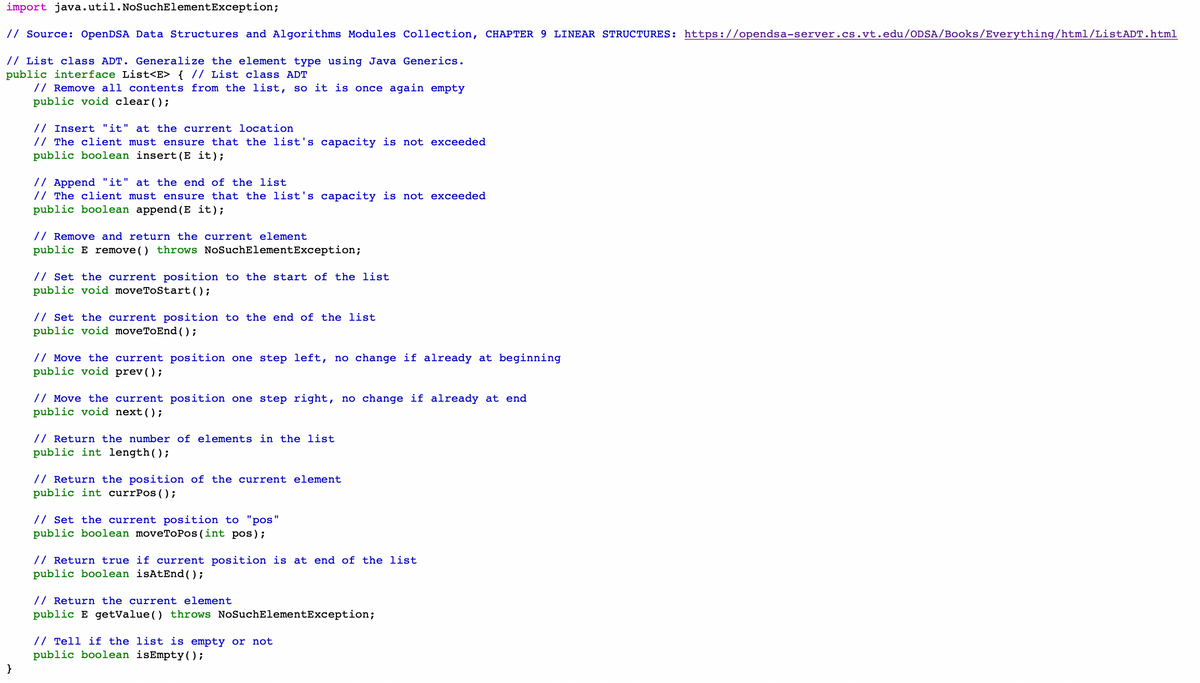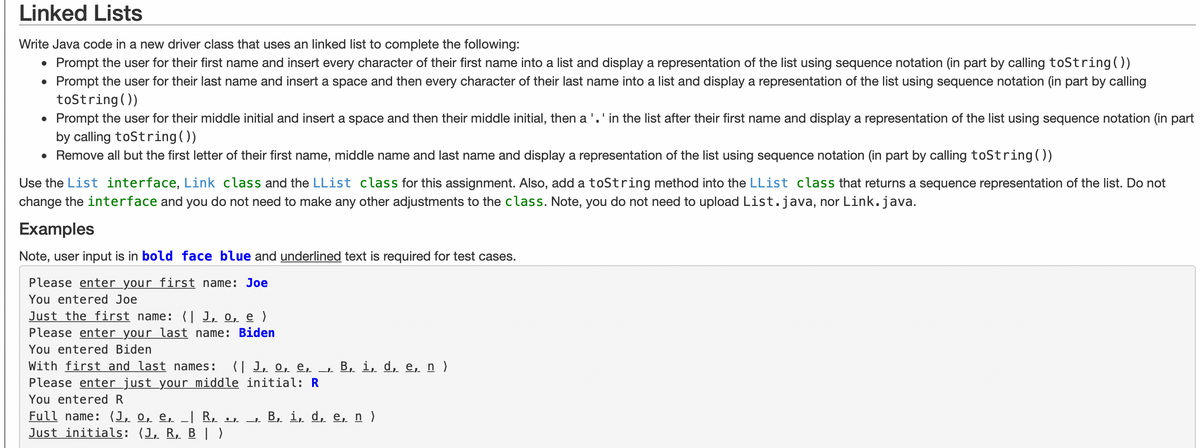the Linked List class: import java.util.NoSuchElementException; // Linked list implementation class LList implements List { private Link head; // Pointer to list header private Link tail; // Pointer to last element private Link curr; // Access to current element private int listSize; // Size of list // Constructors LList(int size) { // Constructor -- Ignore size this(); } LList() { clear(); } // Remove all elements public void clear() { curr = tail = new Link(null); // Create trailer head = new Link(tail); // Create header listSize = 0; } // Insert "it" at current position public boolean insert(E it) { curr.setNext(new Link(curr.element(), curr.next())); curr.setElement(it); if (tail == curr) { tail = curr.next(); // New tail } listSize++; return true; } // Append "it" to list public boolean append(E it) { tail.setNext(new Link(null)); tail.setElement(it); tail = tail.next(); listSize++; return true; } // Remove and return current element public E remove () throws NoSuchElementException { if (curr == tail) {// Nothing to remove throw new NoSuchElementException("remove() in LList has current of " + curr + " and size of " + listSize + " that is not a a valid element"); } E it = curr.element(); // Remember value curr.setElement(curr.next().element()); // Pull forward the next element if (curr.next() == tail) { tail = curr; // Removed last, move tail } curr.setNext(curr.next().next()); // Point around unneeded link listSize--; // Decrement element count return it; // Return value } public void moveToStart() { curr = head.next(); // Set curr at list start } public void moveToEnd() { curr = tail; // Set curr at list end } // Move curr one step left; no change if now at front public void prev() { if (head.next() == curr) { return; // No previous element } Link temp = head; // March down list until we find the previous element while (temp.next() != curr) { temp = temp.next(); } curr = temp; } // Move curr one step right; no change if now at end public void next() { if (curr != tail) { curr = curr.next(); } } public int length() { return listSize; } // Return list length // Return the position of the current element public int currPos() { Link temp = head.next(); int i; for (i=0; curr != temp; i++) { temp = temp.next(); } return i; } // Move down list to "pos" position public boolean moveToPos(int pos) { if ((pos < 0) || (pos > listSize)) { return false; } curr = head.next(); for(int i=0; i
the Linked List class:
import java.util.NoSuchElementException;
// Linked list implementation
class LList<E> implements List<E> {
private Link<E> head; // Pointer to list header
private Link<E> tail; // Pointer to last element
private Link<E> curr; // Access to current element
private int listSize; // Size of list
// Constructors
LList(int size) { // Constructor -- Ignore size
this();
}
LList() {
clear();
}
// Remove all elements
public void clear() {
curr = tail = new Link<E>(null); // Create trailer
head = new Link<E>(tail); // Create header
listSize = 0;
}
// Insert "it" at current position
public boolean insert(E it) {
curr.setNext(new Link<E>(curr.element(), curr.next()));
curr.setElement(it);
if (tail == curr) {
tail = curr.next(); // New tail
}
listSize++;
return true;
}
// Append "it" to list
public boolean append(E it) {
tail.setNext(new Link<E>(null));
tail.setElement(it);
tail = tail.next();
listSize++;
return true;
}
// Remove and return current element
public E remove () throws NoSuchElementException {
if (curr == tail) {// Nothing to remove
throw new NoSuchElementException("remove() in LList has current of " + curr + " and size of "
+ listSize + " that is not a a valid element");
}
E it = curr.element(); // Remember value
curr.setElement(curr.next().element()); // Pull forward the next element
if (curr.next() == tail) {
tail = curr; // Removed last, move tail
}
curr.setNext(curr.next().next()); // Point around unneeded link
listSize--; // Decrement element count
return it; // Return value
}
public void moveToStart() {
curr = head.next(); // Set curr at list start
}
public void moveToEnd() {
curr = tail; // Set curr at list end
}
// Move curr one step left; no change if now at front
public void prev() {
if (head.next() == curr) {
return; // No previous element
}
Link<E> temp = head;
// March down list until we find the previous element
while (temp.next() != curr) {
temp = temp.next();
}
curr = temp;
}
// Move curr one step right; no change if now at end
public void next() { if (curr != tail) { curr = curr.next(); } }
public int length() { return listSize; } // Return list length
// Return the position of the current element
public int currPos() {
Link<E> temp = head.next();
int i;
for (i=0; curr != temp; i++) {
temp = temp.next();
}
return i;
}
// Move down list to "pos" position
public boolean moveToPos(int pos) {
if ((pos < 0) || (pos > listSize)) {
return false;
}
curr = head.next();
for(int i=0; i<pos; i++) { curr = curr.next(); }
return true;
}
// Return true if current position is at end of the list
public boolean isAtEnd() { return curr == tail; }
// Return current element value. Note that null gets returned if curr is at the tail
public E getValue() throws NoSuchElementException {
if (curr == tail) // No current element
{
throw new NoSuchElementException("getvalue() in LList has current of " + curr + " and size of "
+ listSize + " that is not a a valid element");
}
return curr.element();
}
//Tell if the list is empty or not
public boolean isEmpty() {
return listSize == 0;
}
}


Trending now
This is a popular solution!
Step by step
Solved in 3 steps with 1 images

Hello, thank you for helping with this. However, the code needed is a Linked list, not array-list. Any chance you can assist with that?








